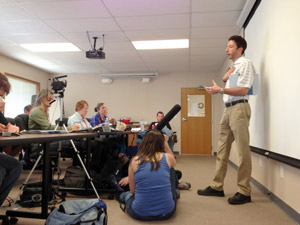
|
| Enbridge spokesman Jason Manshum fields questions from a room full of reporters on the recent Institutes for Journalism & Natural Resources expedition to southwest Michigan. Source: Jeremy Verdusco |
IJNR holds learning expeditions for editors and reporters a few times a year. The first one this year—the one I attended—took participants to the Kalamazoo, Mich., area, the site of one of the worst oil spills in United States history. Other expeditions this year will go to Montana to cover energy exploration issues and to Michigan’s Upper Peninsula to look at mining. Drillers might take working outside for granted, but a pale, works-at-the-computer-all-day editor often needs an excuse to get outside. As far as excuses go, this one was great. We toured superfund sites related to industry on the river, surveyed the site of the 2010 spill and spent time exploring a range of watershed issues. We heard from industry representatives, scientists, environmental groups, and city, state and federal government officials.
It was a lot to soak up in three days and they kept us busy from early to after dark each day. After having a few days afterwards to stew in these issues, I’m struck by the human element within this environmental story. People built the 6B pipeline—the one that failed in Marshall, Mich.—in the 1960s. Residents had to deal with short-term issues like evacuation due to high benzene levels in the area right after the incident, and are left with long-term questions about how long testing will be mandated for their wells and when, or if, contamination might make it to groundwater. Regulators and officials with several levels of government stepped in to help make sure Enbridge, the pipeline’s owner, did the right thing. Yes, the river bore the brunt of the spill. But I can’t put myself in the river’s shoes.
We can all imagine having something as fundamental as our water supply being threatened. I spoke with homeowners along the river and can visualize the nightmare they saw as their beloved river flowed thick with oil (in many cases washing away their property values). I interviewed local officials and heard the concern in their voice as they spoke of the area’s water quality, recreation and wildlife. I listened as Enbridge and industry officials spoke about how the spill was cleaned up and how it can serve as a lesson going forward.
“One of the silver linings of this will be information we can glean from Enbridge and their experiences,” said John Stoody, director of government and public relations for the Association of Oil Pipe Lines, an industry group.
That’s not to give Enbridge and other oil companies a pass when pipelines rupture and threaten our water and environment. While the amount of money at stake is staggering for a company like Enbridge, I don’t believe in malicious intent here. They were slow to realize it was a spill. That much is on the record. But what I think environmental groups and other critics miss is that a big company is made up of people. Any human endeavor, by definition, will be flawed. Where there are pipelines, there will be spills. That’s a terrible truth. But, since few of us are going to give up our cars (or any number of products derived from petroleum), the focus should be on how to quickly and effectively deal with ruptures and spills when they happen.
I hope Stoody’s right and that lessons were learned. One Kalamazoo-area resident I spoke with told me she wept when she heard about the recent spill in Arkansas. She knows from experience that no one should have to go through that. But, while human endeavor is bound to fail sometimes, human ingenuity is just as often bound to overcome. And I would hope we can come together and focus on that ingenuity in situations like this spill and others that potentially threaten the groundwater we all rely on.
Corrections
• The photo that appeared on page 28 of May’s issue was incorrectly attributed. The source for that photo was Holly Forrest.
• The Puradyn feature in April’s issue (“Puradyn Filters Breathe New Life into Oil”) contained an error in the second paragraph. It should have said: “Puradyn oil filtration systems use advanced technology to keep oil cleaner for longer, extending the amount of time between oil changes.”
National Driller regrets the errors.
In other news
If this magazine is in your hand and you’re at the 2013 South Atlantic Jubilee, look me up. My picture’s at the top of this column, so if you see me tap me on the shoulder and say “hello.” I enjoy hearing from readers. Also, when you’re tooling around the expo, check out the products in our Exhibitor’s Choice Showcase, which you can find on page 36.
Stay safe out there, drillers.





Report Abusive Comment